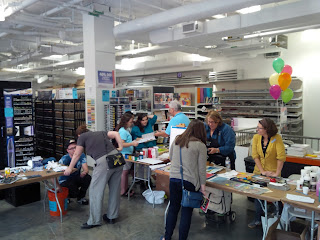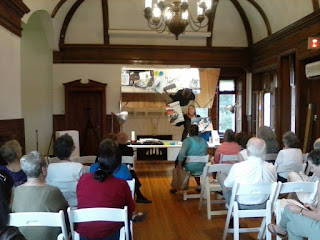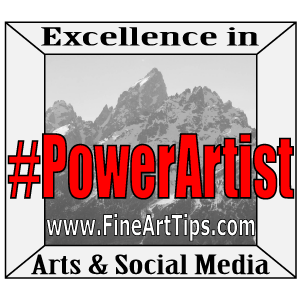Do you know how to identify a good art instructor?
 |
| (Annie Strack teaching plein air painting in Spain) |
My new watercolor class started yesterday at a local arts center. I started my course with the basic lessons about art materials -- I explained the different types, grades, uses, properties, and care of the various materials we use in class -- paper, paints, brushes, and more. How the materials are made, what the ingredients mean and why they are added, explanation of art and painting terms, and on and on and then moving on to drawing and design before getting into painting techniques.
 |
| (Annie Strack filming for television) |
Most of my students have been taking watercolor painting classes from other art teachers at that center for years, and after the class they confided in me that everything I taught was new to them! Their previous teacher/teachers just SHOWED how she painted, but never EXPLAINED her processes -- like what makes a good composition, or why she choose certain colors, or the importance of values, or how color temperatures work, etc., -- nothing.
 |
| (Annie Strack giving the keynote address at the Annual Meeting of the Pennsylvania Watercolor Society) |
My students lamented that their other teachers had never explained the differences between artist grade and student grade materials. Or the difference between washes and glazes. Or how to mix colors, or clean their brushes properly, or the difference between opaque and transparent colors, or, well, anything. They were so grateful to finally have an experienced professional teacher, and they eagerly soaked up knowledge.
| (Annie Strack's students at Nunez College) |
Sadly, I've seen this all too often. A person can be a great artist, and at the same time, have little or no knowledge about art. There's nothing wrong with that. But being able to paint beautifully does not mean that they automatically possess the ability to teach art. I’ve watched lots of talented self-taught artists paint, and many of them have no idea how they create – they “just do it.”
 |
| (Annie Strack teaching at Delaware Watercolor Society) |
Some of these artist can enjoy great success, and their paintings are featured in magazines and even win top awards in major juried exhibits. These are the idiot savants of the art world. People who were never taught how to mix colors or hold a brush, and yet they can produce a beautiful work of art through instinct -- without understanding how they did it.
| (Annie Strack teaching watercolor painting techniques in New Jersey) |
It’s like the people who can play an instrument “by ear,” but can’t read a note of music. Their music can sound perfect, but if they don’t know what key they used, or can’t tell you the name the chords, or show you the difference between flat and sharp, then they can’t teach you how to play the instrument.
 |
| (Annie Strack's workshop students in Mississippi) |
Anyone can call themselves an artist, and any artist can call themselves an art teacher. This is why it’s so important for students to make sure that their teachers are good teachers, as well as good artists.
| (Annie Strack's students at the Bayou Lacombe Art Center) |
I'm seeing some of my former students are advertising that they are now teaching workshops and classes, even though they've only been painting for a short while.
 |
| (Annie Strack teaching a workshop in Ocean City, Maryland) |
Although I make it look easy to my students, art and teaching both require training and practice. Someone may copy my lessons or paintings, but they can't teach from experience that they don't possess.
 |
| (Annie Strack's students and Yves-Marie Salanson of Sennelier in France) |
I have decades of training, knowledge, and experience, and spent years perfecting lessons and developing instructional materials for artists. It's better to learn my material directly from me, rather than from someone who has taken a workshop from me or just watched me demonstrate a technique.
 |
| (Annie Strack teaching at at Rowan College) |
Before you sign up for an art class, make sure the instructor has demonstrated knowledge of whatever it is that she is teaching. Besides experience teaching in legitimate and prestigious venues such as schools, art centers, arts supplies stores, and artist organizations, look for teachers who have glowing references and recommendations.
 |
| (Annie Strack's workshop students in Charleston) |
Most art instructors publish tutorials and lessons, and you can usually find samples online and in print. Look at their online videos and check out their DVDs. Read their tutorials that they wrote for art magazines, for art supply companies, and online blogs. You need to see evidence like these examples that prove the artist's teaching abilities. If you can't find any evidence, then it probably doesn't exist -- and that is a red warning flag!
 |
| (Annie Strack teaching artist materials at Plaza Art Stores) |
The funny thing is, the bad classes are often the same price as the good classes. Would you rather spend your time and money in a class where you won’t learn anything, or would you rather spend that same time and money taking a class from a professional artist who has the knowledge, experience, references, qualifications, and credentials that prove her worth as an extraordinary teacher?
 |
| (Annie Strack teaching for the Louisiana Watercolor Society) |
Don’t sign up for a class just because the artist is a remarkable painter, make sure the artist is a remarkable teacher, too!
 |
| (Annie Strack teaching workshops at Jerry's Artarama's annual Art of the Carolinas) |
Same goes for those of you who book the workshop artists and hire the art instructors – the good teachers don’t cost you any more than the bad ones, so do your homework and get the good ones!
 |
| (Annie Strack teaching for the Philadelphia Watercolor Society) |
There are a lot of art teachers to choose from -- make sure you choose an artist who has a strong background in teaching art, has demonstrated the extent of her abilities by winning tons of awards, is recognized as a top artist by her numerous Signature Memberships, has actually studied art, and is vastly knowledgeable about artist supplies and materials.
Labels: Annie Strack, art instruction, art lesson, art tutorial, artists, Painting Demonstration, painting lesson



